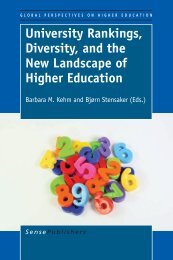Rupturing Concepts of Disability and Inclusion
Rupturing Concepts of Disability and Inclusion
Rupturing Concepts of Disability and Inclusion
You also want an ePaper? Increase the reach of your titles
YUMPU automatically turns print PDFs into web optimized ePapers that Google loves.
CHAPTER 1<br />
‘<strong>Inclusion</strong>’ is a metaconcept. Different facets <strong>of</strong> inclusion can be metaphorically<br />
conceptualised as a position, a belief, an aspiration, a policy, a practice, an action, a<br />
sense <strong>of</strong> being, <strong>and</strong> an ideal. However, it is essential to recognise that inclusion is<br />
conceptually embedded in a dualistic <strong>and</strong> dichotomous relationship with exclusion. 7<br />
Whilst exclusion can be beneficial <strong>and</strong> positive in some contexts by protecting<br />
notions <strong>of</strong> choice, solidarity <strong>and</strong> particular social practices or actions, it is ‘negative<br />
exclusion’ which is most prevalent in the lives <strong>of</strong> people with intellectual disability.<br />
Such negative exclusion is seemingly founded upon lack <strong>of</strong> choice, assumptions <strong>of</strong><br />
inferiority, <strong>and</strong> burden. An inclusion/exclusion relationship is, therefore, structurally<br />
similar to other dichotomies whereby power, hierarchy <strong>and</strong> containment are implicit.<br />
These are dichotomies such as abled <strong>and</strong> disabled, normal <strong>and</strong> abnormal, male <strong>and</strong><br />
female, white <strong>and</strong> black, mind <strong>and</strong> body.<br />
<strong>Inclusion</strong> <strong>and</strong> exclusion are also second-order concepts. They are terms which<br />
cannot exist in their own right such as the objects <strong>of</strong> first order concepts; but which<br />
are conjoined to other concepts such as order, humanity, society, community,<br />
school, group, church <strong>and</strong> so on. <strong>Inclusion</strong> is subjected to the values therein <strong>of</strong> such<br />
concepts, <strong>and</strong> membership is defined on the basis <strong>of</strong> pre-defined legitimacy to be<br />
similar to the dominant members.<br />
It can be claimed, then, that while underst<strong>and</strong>ings <strong>of</strong> integration for people with<br />
disability, particularly intellectual disability, have sought to highlight <strong>and</strong> address<br />
characteristics <strong>of</strong> segregation: proponents <strong>of</strong> the notion <strong>of</strong> inclusion, though<br />
implicitly recognising marginality, have inadequately addressed the structural<br />
dynamics <strong>of</strong> societal <strong>and</strong> community exclusion, that is, morally speaking, inclusion<br />
is so bound up with its opposite – exclusion – that it must be rendered with care. I<br />
contend that addressing structural exclusion is not merely about attending to<br />
‘absence’ or the state <strong>of</strong> ‘being left out’. It involves the intentional deconstruction<br />
<strong>of</strong> processes <strong>of</strong> active exclusion configured with existing relationships <strong>of</strong> power,<br />
orthodoxy, <strong>and</strong> hegemony.<br />
In this research, I promote this extended view. I assert that ‘inclusion’ is not<br />
only a dualistic term in a dichotomous relationship with ‘exclusion’, but also is a<br />
multifaceted, complex concept which comm<strong>and</strong>s a socio-ethical critique. I explore<br />
such an assertion by arguing that historical <strong>and</strong> contemporary conceptualisations<br />
<strong>of</strong> exclusion for people with disability have been constructed from various<br />
philosophical <strong>and</strong> theological matrices imbued with particular values. These matrices,<br />
I contend, are immersed, impregnated, controlled, <strong>and</strong> bounded by contexts <strong>of</strong><br />
patriarchy (rule <strong>of</strong> the father linked to the male-female gender dualism underpinning<br />
the Western Logic <strong>of</strong> Identity) <strong>and</strong> kyriarchy (rule <strong>of</strong> the master <strong>and</strong> Lord linked to<br />
the power <strong>of</strong> social arrangements <strong>and</strong> structures) – contexts to be explored in depth<br />
later. 8 In doing so, I identify two dominating ethics underpinning various practice<br />
frameworks <strong>of</strong> services for people with intellectual disability. These practices<br />
which embrace policies <strong>and</strong> human services in a Judeo-Christian context represent<br />
various types <strong>of</strong> inclusion, <strong>and</strong> are, therefore, mapped with a contextual applied<br />
ethics framework to highlight various assumptions about power, position, personhood<br />
<strong>and</strong> principles within them.<br />
2














